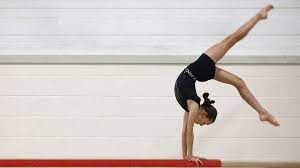Gymnastics for kids does more than build strength and flexibility—it also boosts their academic performance. Studies show that children who regularly participate in gymnastics develop better focus, memory, and problem-solving skills, all of which are key contributors to academic success. From preschool to high school, the connection between physical movement and cognitive ability is backed by science and observable in classrooms every day.
Let’s explore how this high-energy sport positively impacts learning outcomes—and why parents and educators are increasingly turning to gymnastics as a powerful tool for educational support.
How Does Gymnastics Support Brain Development in Children?
Physical activity, particularly complex movement like gymnastics, stimulates the brain’s development. When kids perform flips, balances, and sequences, their brains engage in:
- Cross-lateral movement – improving communication between the brain’s hemispheres.
- Spatial awareness – helping with mathematics and geometry comprehension.
- Memory recall – enhanced through learning and repeating routines.
According to neuroscientific research from the University of Illinois, physical activity can lead to better brain function in school-aged children, with direct benefits for attention control and academic achievement.
What Academic Skills Can Gymnastics Improve?
1. Focus and Concentration
Gymnastics routines require precision, timing, and intense focus. These mental skills translate directly to classroom tasks like reading, problem-solving, and test-taking. The ability to stay calm under pressure—honed on the mat—helps children handle exam anxiety and concentrate for longer periods.
2. Discipline and Goal Setting
Progress in gymnastics is structured. Children learn to set goals, work toward mastering specific skills, and receive feedback—mirroring academic learning. These habits nurture a growth mindset, a key trait linked with academic resilience and long-term achievement.
3. Memory and Sequencing
Practising gymnastics involves memorising sequences of movements, which strengthens working memory. Improved memory skills are particularly helpful in subjects like spelling, languages, and maths where recall plays a major role.
Can Gymnastics Help With Behaviour and Emotional Control?
Yes, significantly. Children who engage in structured sports like gymnastics often show fewer behavioural issues at school. The sport encourages:
- Emotional regulation through breathing techniques and focus.
- Impulse control by waiting for turns and following rules.
- Self-esteem building through achieving personal goals and progressing through levels.
This emotional intelligence leads to better peer relationships, fewer classroom disruptions, and a more positive learning environment.
How Does Physical Fitness Link to Academic Confidence?
Physical competence directly influences a child’s confidence. When kids feel strong and capable, they approach schoolwork with the same mindset. This confidence encourages participation, even in subjects they might struggle with. Plus, regular physical activity reduces symptoms of anxiety and depression—both of which can negatively affect learning.
How Does Gymnastics Compare to Other Sports in Supporting Academic Growth?
While all physical activity is beneficial, gymnastics is uniquely positioned to support academic development due to its:
- Cognitive complexity – coordinating body and mind during routines.
- Individual focus – children track their own progress rather than relying on a team.
- Consistency and repetition – skills are built over time, reinforcing neural pathways.
This blend of mental and physical challenge fosters a well-rounded learner, particularly during foundational years of education.
When Should Kids Start Gymnastics for Academic Benefits?
The earlier, the better. Preschool and early primary school are prime times for developing the motor and cognitive skills that underpin learning. Introducing gymnastics for kids at a young age supports:
- Fine and gross motor skill development
- Bilateral coordination
- Core strength for posture—linked to better handwriting and classroom stamina
Even starting later in childhood can deliver noticeable improvements in focus, resilience, and emotional balance.
How Can Parents and Schools Integrate Gymnastics?
Parents can enrol children in local programs that offer structured, age-appropriate classes. Schools can collaborate with gymnastics centres for excursions or introduce basic movement routines into physical education programs. Encouraging active participation a few times a week is enough to see benefits.
Real-Life Example: Gymnastics Helping a Struggling Student
Take the case of Mia, an eight-year-old who struggled with attention in class. Her parents enrolled her in weekly gymnastics to help with physical fitness. Within three months, her teacher noticed improved concentration, better handwriting, and greater engagement during group work. Mia reported feeling “stronger and happier”—and her grades steadily improved.
This is not an isolated story. Many coaches and teachers observe similar transformations, highlighting the real-world impact of gymnastics on learning outcomes.
FAQ
Q: Is gymnastics for kids suitable for children with learning difficulties?
A: Yes. In fact, the structured and sensory-rich environment can support kids with ADHD, autism, and other learning challenges by improving motor planning, focus, and emotional regulation.
Q: How often should kids do gymnastics to see academic benefits?
A: Two to three sessions per week is ideal for noticeable improvements in focus and behaviour, but even one weekly class can support cognitive and emotional development.
Q: What age is best to start gymnastics?
A: Children can begin as early as 18 months in parent-and-toddler programs, with independent classes starting around age three. The earlier they start, the more integrated the benefits become with their learning journey.
Conclusion
Gymnastics for kids is far more than a fun extracurricular activity. It builds the cognitive and emotional foundations for success in the classroom—boosting focus, memory, confidence, and resilience. As more schools and parents recognise the academic power of movement, gymnastics is fast becoming a core part of holistic education strategies.
For those exploring broader options in youth development, gymnastics sits high on the list of kids’ physical activities that genuinely shape both body and brain.

